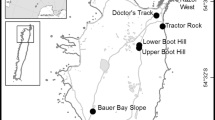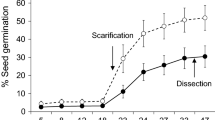Abstract
Gaps in grassland created by animals are often sites for species regeneration. The persistent seed banks of ant-hills and surrounding soils in a calcareous grassland in southern Britain were compared and analysed in terms of seed mass and longevity. The relative abundance of species on ant-hills compared to the pasture was highly correlated with seed abundance in ant-hill soil. The abundance of plant species on ant-hills compared to the pasture was significantly negatively correlated with seed mass, and positively correlated with seed longevity. These results suggest that germination from the seed bank in ant-hill soils, as well as limited seed dispersal and vegetative invasion, contributes to the distinctive ant-hill vegetation. The same may apply to other gaps created by animals in grasslands.

Similar content being viewed by others
References
Dai XB (2000) Impact of cattle dung deposition on the distribution pattern of plant species in an alvar limestone grassland. J Veg Sci 11:715–724
Dostal P (2005a) Effect of three mound-building ant species on the formation of soil seed bank in mountain grassland. Flora 200:148–158
Dostal P (2005b) Is the population turnover of patchily-distributed annuals determined by dormancy dynamics or dispersal processes? Ecography 28:745–756
Dostal P, Breznova M, Kozlickova V, Herben T, Kovar P (2005) Ant-induced soil modification and its effect on plant below-ground biomass. Pedobiologia 49:127–137
Fenner M, Thompson K (2005) The ecology of seeds. Cambridge University Press
Fischer SF, Poschlod P, Beinlich B (1996) Experimental studies on the dispersal of plants and animals on sheep in calcareous grasslands. J Appl Ecol 33:1206–1222
Gigon A, Leutert AG (1996) The Dynamic keyhole key model of coexistence to explain diversity of plants in limestone and other grasslands. J Veg Sci 7:29–40
Grime JP, Hodgson JG, Hunt R (1988) Comparative plant ecology. Unwin Hyman, London
Kalamees R, Zobel M (2002) The role of the seed bank in gap regeneration in a calcareous grassland community. Ecology 83:1017–1025
King TJ (1975) Inhibition of germination under leaf canopies in Arenaria serpyllifolia, Veronica arvensis and Cerastium holosteoides. New Phytologist 75:87–90
King TJ (1976) The viable seed contents of ant-hill and pasture soil. New Phytologist 77:143–147
King TJ (1977a) The plant ecology of ant-hills in calcareous grasslands. 1. Patterns of species in relation to ant-hills in southern England. J Ecol 65:237–256
King TJ (1977b) The plant ecology of ant-hills in calcareous grasslands. II. Succession on the mounds. J Ecol 65:257–278
King TJ (1977c) The plant ecology of ant-hills in calcareous grasslands. III. Factors affecting the population sizes of selected species on ant-hills. J Ecol 65:279–315
King TJ (1981) Ant-hill vegetation of acidic grasslands in the Gower peninsula, South Wales. New Phytol 88:559–571
Pakeman RJ, Attwood JP, Engelen J (1988) Sources of plants colonising experimentally-disturbed patches in an acidic grassland in Eastern England. J Ecol 86:1032–1041
Pakeman RJ, Engelen J, Attwood JP (1999) Rabbit endozoochory and seedbank buildup in an acidic grassland. Plant Ecol 145:83–90
Pakeman RJ, Small JL (2005) The role of the seed bank, seed rain and timing of disturbance in gap regeneration. J Veg Sci 16:121–130
Rodwell JS (1992) British plant communities, vol. 3. Grasslands and montane communities. Cambridge University Press, Cambridge
Siegel S, Castellan NJ (1988) Nonparametric statistics for the behavioural sciences. 2nd edn. McGraw Hill, New York
Sokal RR, Rohlf FJ (1995) Biometry. 3rd edn. Freeman, New York
Soons MB, Heil GW, Nathan R, Katul GG (2004) Determinants of long-distance dispersal by wind in grasslands. Ecology 85:3056–3068
Stace C (1997) New flora of the British Isles. 2nd edn. Cambridge University Press, Cambridge
Tackenberg O (2003) Modeling long-distance dispersal of plant diaspores by wind. Ecol Monogr 73:173–189
Thompson K, Bakker JP, Bekker RM (1997) Soil seed banks of North West Europe; methodology, density and longevity. Cambridge University Press, Cambridge
Thompson K, Bakker JP Bekker RM, Hodgson JG (1998) Ecological correlates of seed persistence in soil in the north-western European flora. J Ecol 86:163–169
Turnbull LA, Manley L, Rees M (2005) Niches, rather than neutrality, structure a grassland pioneer guild. Proc Roy Soc B 272:1357–1364
Acknowledgements
Thanks to Ken Thompson and Peter Grubb for discussions and to the Nuffield Foundation and Sidney Sussex College, Cambridge for financial support.
Author information
Authors and Affiliations
Corresponding author
Rights and permissions
About this article
Cite this article
King, T.J. The roles of seed mass and persistent seed banks in gap colonisation in grassland. Plant Ecol 193, 233–239 (2007). https://doi.org/10.1007/s11258-006-9261-x
Received:
Accepted:
Published:
Issue Date:
DOI: https://doi.org/10.1007/s11258-006-9261-x




